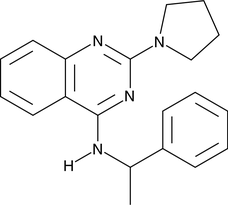Chemicals
Showing 22501–22650 of 41137 results
-
Iloprost is a second generation structural analog of prostacyclin (PGI) with about ten-fold greater potency than the first generation stable analogs, typified by carbaprostacyclin.{3347} Iloprost binds with equal affinity to the human recombinant IP and EP1 receptors with a Ki of 11 nM.{8322} Iloprost constricts the isolated guinea pig ilium and fundus circular smooth muscle (an EP1 receptor preparation) as strongly as prostaglandin E2 (PGE2) itself.{3412} Iloprost inhibits the ADP, thrombin, and collagen-induced aggregation of human platelets with an ED50 of about 13 nM.{3347} In whole animals, iloprost acts as a vasodilator, hypotensive, antidiuretic, and prolongs bleeding time.{680} It has been evaluated in several human clinical studies as a treatment for idiopathic pulmonary hypertension.{9656,10375} In these studies, an aerosolized dose of 30 µg/day was effective, and doses as high as 150 µg/day for up to a year were well tolerated.
Brand:CaymanSKU:-Available on backorder
Glycogen synthase kinase 3β (GSK3β) is a constitutively active serine/threonine protein kinase implicated in several important regulatory processes. It can phosphorylate β-catenin, an intracellular signal transducer in the Wnt signaling pathway, which leads to β-catenin degradation. IM-12 is a non-symmetrically substituted indolylmaleimide that increases β-catenin levels by inhibiting GSK3β (IC50 = 53 nM).{28767,28768} It has been shown to reduce proliferation and increase differentiation of a ReNCell VM cell line derived from human ventral midbrain.{28768} IM-12 is also reported to have a depolymerizing effect on in vitro tubulin assembly.{28769}
Brand:CaymanSKU:-Available on backorder
Glycogen synthase kinase 3β (GSK3β) is a constitutively active serine/threonine protein kinase implicated in several important regulatory processes. It can phosphorylate β-catenin, an intracellular signal transducer in the Wnt signaling pathway, which leads to β-catenin degradation. IM-12 is a non-symmetrically substituted indolylmaleimide that increases β-catenin levels by inhibiting GSK3β (IC50 = 53 nM).{28767,28768} It has been shown to reduce proliferation and increase differentiation of a ReNCell VM cell line derived from human ventral midbrain.{28768} IM-12 is also reported to have a depolymerizing effect on in vitro tubulin assembly.{28769}
Brand:CaymanSKU:-Available on backorder
Glycogen synthase kinase 3β (GSK3β) is a constitutively active serine/threonine protein kinase implicated in several important regulatory processes. It can phosphorylate β-catenin, an intracellular signal transducer in the Wnt signaling pathway, which leads to β-catenin degradation. IM-12 is a non-symmetrically substituted indolylmaleimide that increases β-catenin levels by inhibiting GSK3β (IC50 = 53 nM).{28767,28768} It has been shown to reduce proliferation and increase differentiation of a ReNCell VM cell line derived from human ventral midbrain.{28768} IM-12 is also reported to have a depolymerizing effect on in vitro tubulin assembly.{28769}
Brand:CaymanSKU:-Available on backorder
Glycogen synthase kinase 3β (GSK3β) is a constitutively active serine/threonine protein kinase implicated in several important regulatory processes. It can phosphorylate β-catenin, an intracellular signal transducer in the Wnt signaling pathway, which leads to β-catenin degradation. IM-12 is a non-symmetrically substituted indolylmaleimide that increases β-catenin levels by inhibiting GSK3β (IC50 = 53 nM).{28767,28768} It has been shown to reduce proliferation and increase differentiation of a ReNCell VM cell line derived from human ventral midbrain.{28768} IM-12 is also reported to have a depolymerizing effect on in vitro tubulin assembly.{28769}
Brand:CaymanSKU:-Available on backorder
IM-54 is an indolylmaleimide derivative which, at 1 μM, inhibits necrotic cell death induced by H2O2 in promyelocytic leukemia HL-60 cells.{17455} It does not prevent etoposide-induced apoptosis and does not inhibit protein kinase C or S6 kinase 1.{17455}
Brand:CaymanSKU:-IM-54 is an indolylmaleimide derivative which, at 1 μM, inhibits necrotic cell death induced by H2O2 in promyelocytic leukemia HL-60 cells.{17455} It does not prevent etoposide-induced apoptosis and does not inhibit protein kinase C or S6 kinase 1.{17455}
Brand:CaymanSKU:-IM-54 is an indolylmaleimide derivative which, at 1 μM, inhibits necrotic cell death induced by H2O2 in promyelocytic leukemia HL-60 cells.{17455} It does not prevent etoposide-induced apoptosis and does not inhibit protein kinase C or S6 kinase 1.{17455}
Brand:CaymanSKU:-IM-54 is an indolylmaleimide derivative which, at 1 μM, inhibits necrotic cell death induced by H2O2 in promyelocytic leukemia HL-60 cells.{17455} It does not prevent etoposide-induced apoptosis and does not inhibit protein kinase C or S6 kinase 1.{17455}
Brand:CaymanSKU:-IM-93 is a dual inhibitor of ferroptosis and NETosis.{50250} It inhibits tert-butyl hydroperoxide- and erastin-induced ferroptosis in NIH3T3 cells (IC50s =1.8 and 1.9 nM, respectively), as well as decreases NETosis induced by phorbol 12-myristate 13-acetate (PMA; Item No. 10008014) in isolated human peripheral blood neutrophils when used at concentrations ranging from 1.6 to 25 µM. IM-93 also inhibits hydrogen peroxide-induced necrosis in HL-60 cells (IC50 = 0.45 µM), but has no effect on necroptosis induced by Fas ligand in combination with Z-VAD-FMK and cycloheximide (Item No. 14126) in Jurkat cells or pyroptosis induced by S. aureus and P. aeruginosa in THP-1 cells when used at a concentration of 25 µM.
Brand:CaymanSKU:28794 - 1 mgAvailable on backorder
IM-93 is a dual inhibitor of ferroptosis and NETosis.{50250} It inhibits tert-butyl hydroperoxide- and erastin-induced ferroptosis in NIH3T3 cells (IC50s =1.8 and 1.9 nM, respectively), as well as decreases NETosis induced by phorbol 12-myristate 13-acetate (PMA; Item No. 10008014) in isolated human peripheral blood neutrophils when used at concentrations ranging from 1.6 to 25 µM. IM-93 also inhibits hydrogen peroxide-induced necrosis in HL-60 cells (IC50 = 0.45 µM), but has no effect on necroptosis induced by Fas ligand in combination with Z-VAD-FMK and cycloheximide (Item No. 14126) in Jurkat cells or pyroptosis induced by S. aureus and P. aeruginosa in THP-1 cells when used at a concentration of 25 µM.
Brand:CaymanSKU:28794 - 10 mgAvailable on backorder
IM-93 is a dual inhibitor of ferroptosis and NETosis.{50250} It inhibits tert-butyl hydroperoxide- and erastin-induced ferroptosis in NIH3T3 cells (IC50s =1.8 and 1.9 nM, respectively), as well as decreases NETosis induced by phorbol 12-myristate 13-acetate (PMA; Item No. 10008014) in isolated human peripheral blood neutrophils when used at concentrations ranging from 1.6 to 25 µM. IM-93 also inhibits hydrogen peroxide-induced necrosis in HL-60 cells (IC50 = 0.45 µM), but has no effect on necroptosis induced by Fas ligand in combination with Z-VAD-FMK and cycloheximide (Item No. 14126) in Jurkat cells or pyroptosis induced by S. aureus and P. aeruginosa in THP-1 cells when used at a concentration of 25 µM.
Brand:CaymanSKU:28794 - 25 mgAvailable on backorder
IM-93 is a dual inhibitor of ferroptosis and NETosis.{50250} It inhibits tert-butyl hydroperoxide- and erastin-induced ferroptosis in NIH3T3 cells (IC50s =1.8 and 1.9 nM, respectively), as well as decreases NETosis induced by phorbol 12-myristate 13-acetate (PMA; Item No. 10008014) in isolated human peripheral blood neutrophils when used at concentrations ranging from 1.6 to 25 µM. IM-93 also inhibits hydrogen peroxide-induced necrosis in HL-60 cells (IC50 = 0.45 µM), but has no effect on necroptosis induced by Fas ligand in combination with Z-VAD-FMK and cycloheximide (Item No. 14126) in Jurkat cells or pyroptosis induced by S. aureus and P. aeruginosa in THP-1 cells when used at a concentration of 25 µM.
Brand:CaymanSKU:28794 - 5 mgAvailable on backorder
Imatinib is an inhibitor of the receptor tyrosine kinases c-Abl, Bcr-Abl, PDGFR, and c-Kit.{47196} It inhibits ligand-stimulated autophosphorylation of PDGFR and c-Kit (IC50s = ~0.3 and ~0.1 μM, respectively).{47196,47197} Imatinib inhibits the proliferation of Bcr-Abl-dependent R10(–) cells (IC50s = ~35-40 nM) and HMC-1 cells expressing constitutively active c-Kit in a concentration-dependent manner.{47196, 20180} It prolongs survival in a mouse model of chronic myeloid leukemia when administered at a dose of 100 mg/kg twice per day.{20177} Imatinib (25 and 50 µM) also inhibits the replication of Middle East respiratory syndrome coronavirus (MERS-CoV) and severe acute respiratory syndrome CoV (SARS-CoV) in Vero E6 cells.{57353} It reduces viral titers in Vero cells infected with infectious bronchitis virus (IBV), a coronavirus, when used at a concentration of 10 µM via inhibition of IBV surface glycoprotein protein-induced syncytia formation and virus-cell fusion.{45828} Formulations containing imatinib have been used in the treatment of various cancers.
Brand:CaymanSKU:-Imatinib is an inhibitor of the receptor tyrosine kinases c-Abl, Bcr-Abl, PDGFR, and c-Kit.{47196} It inhibits ligand-stimulated autophosphorylation of PDGFR and c-Kit (IC50s = ~0.3 and ~0.1 μM, respectively).{47196,47197} Imatinib inhibits the proliferation of Bcr-Abl-dependent R10(–) cells (IC50s = ~35-40 nM) and HMC-1 cells expressing constitutively active c-Kit in a concentration-dependent manner.{47196, 20180} It prolongs survival in a mouse model of chronic myeloid leukemia when administered at a dose of 100 mg/kg twice per day.{20177} Imatinib (25 and 50 µM) also inhibits the replication of Middle East respiratory syndrome coronavirus (MERS-CoV) and severe acute respiratory syndrome CoV (SARS-CoV) in Vero E6 cells.{57353} It reduces viral titers in Vero cells infected with infectious bronchitis virus (IBV), a coronavirus, when used at a concentration of 10 µM via inhibition of IBV surface glycoprotein protein-induced syncytia formation and virus-cell fusion.{45828} Formulations containing imatinib have been used in the treatment of various cancers.
Brand:CaymanSKU:-Imatinib is an inhibitor of the receptor tyrosine kinases c-Abl, Bcr-Abl, PDGFR, and c-Kit.{47196} It inhibits ligand-stimulated autophosphorylation of PDGFR and c-Kit (IC50s = ~0.3 and ~0.1 μM, respectively).{47196,47197} Imatinib inhibits the proliferation of Bcr-Abl-dependent R10(–) cells (IC50s = ~35-40 nM) and HMC-1 cells expressing constitutively active c-Kit in a concentration-dependent manner.{47196, 20180} It prolongs survival in a mouse model of chronic myeloid leukemia when administered at a dose of 100 mg/kg twice per day.{20177} Imatinib (25 and 50 µM) also inhibits the replication of Middle East respiratory syndrome coronavirus (MERS-CoV) and severe acute respiratory syndrome CoV (SARS-CoV) in Vero E6 cells.{57353} It reduces viral titers in Vero cells infected with infectious bronchitis virus (IBV), a coronavirus, when used at a concentration of 10 µM via inhibition of IBV surface glycoprotein protein-induced syncytia formation and virus-cell fusion.{45828} Formulations containing imatinib have been used in the treatment of various cancers.
Brand:CaymanSKU:-Imatinib is an inhibitor of the receptor tyrosine kinases c-Abl, Bcr-Abl, PDGFR, and c-Kit.{47196} It inhibits ligand-stimulated autophosphorylation of PDGFR and c-Kit (IC50s = ~0.3 and ~0.1 μM, respectively).{47196,47197} Imatinib inhibits the proliferation of Bcr-Abl-dependent R10(–) cells (IC50s = ~35-40 nM) and HMC-1 cells expressing constitutively active c-Kit in a concentration-dependent manner.{47196, 20180} It prolongs survival in a mouse model of chronic myeloid leukemia when administered at a dose of 100 mg/kg twice per day.{20177} Imatinib (25 and 50 µM) also inhibits the replication of Middle East respiratory syndrome coronavirus (MERS-CoV) and severe acute respiratory syndrome CoV (SARS-CoV) in Vero E6 cells.{57353} It reduces viral titers in Vero cells infected with infectious bronchitis virus (IBV), a coronavirus, when used at a concentration of 10 µM via inhibition of IBV surface glycoprotein protein-induced syncytia formation and virus-cell fusion.{45828} Formulations containing imatinib have been used in the treatment of various cancers.
Brand:CaymanSKU:-Imatinib-d3 is intended for use as an internal standard for the quantification of imatinib (Item No. 13139) by GC- or LC-MS. Imatinib is an inhibitor of the receptor tyrosine kinases c-Abl, Bcr-Abl, PDGFR, and c-Kit.{47196} It inhibits ligand-stimulated autophosphorylation of PDGFR and c-Kit (IC50s = ~0.3 and ~0.1 μM, respectively).{47196,47197} Imatinib inhibits the proliferation of Bcr-Abl-dependent R10(–) cells (IC50s = ~35-40 nM) and HMC-1 cells expressing constitutively active c-Kit in a concentration-dependent manner.{47196, 20180} It prolongs survival in a mouse model of chronic myeloid leukemia when administered at a dose of 100 mg/kg twice per day.{20177} Imatinib (25 and 50 µM) also inhibits the replication of Middle East respiratory syndrome coronavirus (MERS-CoV) and severe acute respiratory syndrome CoV (SARS-CoV) in Vero E6 cells.{57353} It reduces viral titers in Vero cells infected with infectious bronchitis virus (IBV), a coronavirus, when used at a concentration of 10 µM via inhibition of IBV surface glycoprotein protein-induced syncytia formation and virus-cell fusion.{45828} Formulations containing imatinib have been used in the treatment of various cancers.
Brand:CaymanSKU:-Available on backorder
Imatinib-d3 is intended for use as an internal standard for the quantification of imatinib (Item No. 13139) by GC- or LC-MS. Imatinib is an inhibitor of the receptor tyrosine kinases c-Abl, Bcr-Abl, PDGFR, and c-Kit.{47196} It inhibits ligand-stimulated autophosphorylation of PDGFR and c-Kit (IC50s = ~0.3 and ~0.1 μM, respectively).{47196,47197} Imatinib inhibits the proliferation of Bcr-Abl-dependent R10(–) cells (IC50s = ~35-40 nM) and HMC-1 cells expressing constitutively active c-Kit in a concentration-dependent manner.{47196, 20180} It prolongs survival in a mouse model of chronic myeloid leukemia when administered at a dose of 100 mg/kg twice per day.{20177} Imatinib (25 and 50 µM) also inhibits the replication of Middle East respiratory syndrome coronavirus (MERS-CoV) and severe acute respiratory syndrome CoV (SARS-CoV) in Vero E6 cells.{57353} It reduces viral titers in Vero cells infected with infectious bronchitis virus (IBV), a coronavirus, when used at a concentration of 10 µM via inhibition of IBV surface glycoprotein protein-induced syncytia formation and virus-cell fusion.{45828} Formulations containing imatinib have been used in the treatment of various cancers.
Brand:CaymanSKU:-Available on backorder
Imazalil is an imidazole fungicide that inhibits ergosterol biosynthesis.{36810} Imazalil inhibits the growth of various fungi in vitro including P. italicum, A. niger, U. maydis, B. alii, and C. cucumerinum in a pH-dependent manner (MICs = 0.005-2 μg/ml at pH 7).{37752} It inhibits S. cerevisiae, but not rat liver microsomal, cytochrome P450 enzymes (CYPs; IC50s = 0.088 and 80 μM, respectively), as well as aromatase CYP19 from human placental microsomes (IC50 = 0.34 μM).{36810,37753} Imazalil activates the murine pregnane X receptor (PXR) in a concentration-dependent manner in a cell-based reporter assay.{37754} It increases hepatic CYP3A11 and CYP2B10 mRNA levels in mice when administered at a dose of 100 mg/kg. Imazalil also increases Ki-67-positive nuclei in liver sections and hepatic MCM2 mRNA levels, markers of cell proliferation, in mice when co-administered with the murine constitutive androstane receptor (mCAR) agonist TCPOBOP (Item No. 14140). Formulations containing imazalil have been used to control fungal infection in agriculture.
Brand:CaymanSKU:25815 - 100 mgAvailable on backorder
Imazalil is an imidazole fungicide that inhibits ergosterol biosynthesis.{36810} Imazalil inhibits the growth of various fungi in vitro including P. italicum, A. niger, U. maydis, B. alii, and C. cucumerinum in a pH-dependent manner (MICs = 0.005-2 μg/ml at pH 7).{37752} It inhibits S. cerevisiae, but not rat liver microsomal, cytochrome P450 enzymes (CYPs; IC50s = 0.088 and 80 μM, respectively), as well as aromatase CYP19 from human placental microsomes (IC50 = 0.34 μM).{36810,37753} Imazalil activates the murine pregnane X receptor (PXR) in a concentration-dependent manner in a cell-based reporter assay.{37754} It increases hepatic CYP3A11 and CYP2B10 mRNA levels in mice when administered at a dose of 100 mg/kg. Imazalil also increases Ki-67-positive nuclei in liver sections and hepatic MCM2 mRNA levels, markers of cell proliferation, in mice when co-administered with the murine constitutive androstane receptor (mCAR) agonist TCPOBOP (Item No. 14140). Formulations containing imazalil have been used to control fungal infection in agriculture.
Brand:CaymanSKU:25815 - 50 mgAvailable on backorder
IMD 0354 is an IKKβ (IKK2) inhibitor that blocks NF-κB phosphorylation (IC50 = ~250 nM) and subsequent NF-κB p65 nuclear translocation.{28402} It exhibits cardioprotective properties by decreasing expression of P-selectin and ICAM-1 in the vasculature and blocking cardiomyocyte IL-1β and MCP-1 production, resulting in suppressed neutrophil accumulation in a rat model of ischemia/reperfusion injury.{28402} IMD 0354, suppresses the growth of human breast cancer cells by inducing cell cycle arrest and apoptosis.{28404} It induces apoptosis of chronic lymphocytic leukemia cells at 1-10 µM by directly targeting the NF-κB pathway, decreasing expression of anti-apoptotic genes and increasing expression of proapoptotic genes.{28403}
Brand:CaymanSKU:-Available on backorder
IMD 0354 is an IKKβ (IKK2) inhibitor that blocks NF-κB phosphorylation (IC50 = ~250 nM) and subsequent NF-κB p65 nuclear translocation.{28402} It exhibits cardioprotective properties by decreasing expression of P-selectin and ICAM-1 in the vasculature and blocking cardiomyocyte IL-1β and MCP-1 production, resulting in suppressed neutrophil accumulation in a rat model of ischemia/reperfusion injury.{28402} IMD 0354, suppresses the growth of human breast cancer cells by inducing cell cycle arrest and apoptosis.{28404} It induces apoptosis of chronic lymphocytic leukemia cells at 1-10 µM by directly targeting the NF-κB pathway, decreasing expression of anti-apoptotic genes and increasing expression of proapoptotic genes.{28403}
Brand:CaymanSKU:-Available on backorder
IMD 0354 is an IKKβ (IKK2) inhibitor that blocks NF-κB phosphorylation (IC50 = ~250 nM) and subsequent NF-κB p65 nuclear translocation.{28402} It exhibits cardioprotective properties by decreasing expression of P-selectin and ICAM-1 in the vasculature and blocking cardiomyocyte IL-1β and MCP-1 production, resulting in suppressed neutrophil accumulation in a rat model of ischemia/reperfusion injury.{28402} IMD 0354, suppresses the growth of human breast cancer cells by inducing cell cycle arrest and apoptosis.{28404} It induces apoptosis of chronic lymphocytic leukemia cells at 1-10 µM by directly targeting the NF-κB pathway, decreasing expression of anti-apoptotic genes and increasing expression of proapoptotic genes.{28403}
Brand:CaymanSKU:-Available on backorder
IMD 0354 is an IKKβ (IKK2) inhibitor that blocks NF-κB phosphorylation (IC50 = ~250 nM) and subsequent NF-κB p65 nuclear translocation.{28402} It exhibits cardioprotective properties by decreasing expression of P-selectin and ICAM-1 in the vasculature and blocking cardiomyocyte IL-1β and MCP-1 production, resulting in suppressed neutrophil accumulation in a rat model of ischemia/reperfusion injury.{28402} IMD 0354, suppresses the growth of human breast cancer cells by inducing cell cycle arrest and apoptosis.{28404} It induces apoptosis of chronic lymphocytic leukemia cells at 1-10 µM by directly targeting the NF-κB pathway, decreasing expression of anti-apoptotic genes and increasing expression of proapoptotic genes.{28403}
Brand:CaymanSKU:-Available on backorder
Imetit is a histamine H3 and H4 receptor agonist (Kis = 0.3 and 2.7 nM, respectively, in radioligand binding assays).{52174} It is selective for histamine H3 and H4 receptors over H1 and H2 receptors at concentrations up to 100 µM, as well as the serotonin (5-HT) receptor subtype 5-HT3 (Ki = 240 nM).{52175},{52176} Imetit reduces potassium-induced increases in histamine levels in isolated rat cerebral cortex slices (EC50 = 2.8 nM).{52177} It increases scratching in mice (ED50 = 0.9 µmol), an effect that is reduced by the H3 receptor antagonist thioperamide (Item No. 10011127).{52178}
Brand:CaymanSKU:29517 - 10 mgAvailable on backorder
Imetit is a histamine H3 and H4 receptor agonist (Kis = 0.3 and 2.7 nM, respectively, in radioligand binding assays).{52174} It is selective for histamine H3 and H4 receptors over H1 and H2 receptors at concentrations up to 100 µM, as well as the serotonin (5-HT) receptor subtype 5-HT3 (Ki = 240 nM).{52175},{52176} Imetit reduces potassium-induced increases in histamine levels in isolated rat cerebral cortex slices (EC50 = 2.8 nM).{52177} It increases scratching in mice (ED50 = 0.9 µmol), an effect that is reduced by the H3 receptor antagonist thioperamide (Item No. 10011127).{52178}
Brand:CaymanSKU:29517 - 5 mgAvailable on backorder
Imidacloprid is a broad-spectrum neonicotinoid insecticide that is effective against sucking and biting insects and insects of the Coleopteran and Lepidoptera orders.{42081,42083} It is an agonist of insect acetylcholine receptors (nAchRs) with Ki values of 1.9, 2.1, 290, and 50 nM for M. persicae and D. melanogaster receptors, rat brain membranes, and rat recombinant receptors containing α4β2 subunits, respectively.{42082,33400} Imidacloprid is lethal to M. persicae with LD95 values of approximately 2 and 160 pg/aphid via oral and topical administration, respectively.{42083} It impairs aversive learning and memory retention in honey bees following chronic sublethal exposure of 20.8 ppb.{42084} In a mouse model of high-fat diet-induced obesity, imidacloprid (0.06-6 mg/kg per day) increases body weight gain and adiposity and impairs glucose metabolism without increasing total food intake.{42085}
Brand:CaymanSKU:24130 - 100 mgAvailable on backorder
Imidacloprid is a broad-spectrum neonicotinoid insecticide that is effective against sucking and biting insects and insects of the Coleopteran and Lepidoptera orders.{42081,42083} It is an agonist of insect acetylcholine receptors (nAchRs) with Ki values of 1.9, 2.1, 290, and 50 nM for M. persicae and D. melanogaster receptors, rat brain membranes, and rat recombinant receptors containing α4β2 subunits, respectively.{42082,33400} Imidacloprid is lethal to M. persicae with LD95 values of approximately 2 and 160 pg/aphid via oral and topical administration, respectively.{42083} It impairs aversive learning and memory retention in honey bees following chronic sublethal exposure of 20.8 ppb.{42084} In a mouse model of high-fat diet-induced obesity, imidacloprid (0.06-6 mg/kg per day) increases body weight gain and adiposity and impairs glucose metabolism without increasing total food intake.{42085}
Brand:CaymanSKU:24130 - 25 mgAvailable on backorder
Imidacloprid is a broad-spectrum neonicotinoid insecticide that is effective against sucking and biting insects and insects of the Coleopteran and Lepidoptera orders.{42081,42083} It is an agonist of insect acetylcholine receptors (nAchRs) with Ki values of 1.9, 2.1, 290, and 50 nM for M. persicae and D. melanogaster receptors, rat brain membranes, and rat recombinant receptors containing α4β2 subunits, respectively.{42082,33400} Imidacloprid is lethal to M. persicae with LD95 values of approximately 2 and 160 pg/aphid via oral and topical administration, respectively.{42083} It impairs aversive learning and memory retention in honey bees following chronic sublethal exposure of 20.8 ppb.{42084} In a mouse model of high-fat diet-induced obesity, imidacloprid (0.06-6 mg/kg per day) increases body weight gain and adiposity and impairs glucose metabolism without increasing total food intake.{42085}
Brand:CaymanSKU:24130 - 50 mgAvailable on backorder
Imidapril is a prodrug for the active metabolite imidaprilat, an angiotensin-converting enzyme inhibitor that suppresses the conversion of angiotensin I to angiotensin II (IC50 = 2.6 nM), thereby preventing vasoconstriction and decreasing aldosterone secretion by the adrenal cortex.{30612} In clinical trials, imidapril was effective at lowering plasma and tissue angiotensin II levels, resulting in peripheral vasodilation, reduced blood pressure, renoprotective effects in patients with type 1 diabetes, and decreased renal sodium and water retention.{30613,30611}
Brand:CaymanSKU:-Available on backorder
Imidapril is a prodrug for the active metabolite imidaprilat, an angiotensin-converting enzyme inhibitor that suppresses the conversion of angiotensin I to angiotensin II (IC50 = 2.6 nM), thereby preventing vasoconstriction and decreasing aldosterone secretion by the adrenal cortex.{30612} In clinical trials, imidapril was effective at lowering plasma and tissue angiotensin II levels, resulting in peripheral vasodilation, reduced blood pressure, renoprotective effects in patients with type 1 diabetes, and decreased renal sodium and water retention.{30613,30611}
Brand:CaymanSKU:-Available on backorder
Imidapril is a prodrug for the active metabolite imidaprilat, an angiotensin-converting enzyme inhibitor that suppresses the conversion of angiotensin I to angiotensin II (IC50 = 2.6 nM), thereby preventing vasoconstriction and decreasing aldosterone secretion by the adrenal cortex.{30612} In clinical trials, imidapril was effective at lowering plasma and tissue angiotensin II levels, resulting in peripheral vasodilation, reduced blood pressure, renoprotective effects in patients with type 1 diabetes, and decreased renal sodium and water retention.{30613,30611}
Brand:CaymanSKU:-Available on backorder
Imidazole ketone erastin is an inducer of ferroptosis.{50040} It inhibits glutamate release in human CCF-STTG1 astrocytoma cells (IC50 = 30 nM), indicating inhibition of the system xc- cystine/glutamate transporter.{43385} Imidazole ketone erastin increases production of lipid reactive oxygen species (ROS) in SUDHL6 diffuse large B cell lymphoma (DLBCL) cells in a concentration-dependent manner, as well as reduces glutathione (GSH) levels in these cells (IC50 = 34 nM).{50040} It inhibits the growth of HT-1080 fibrosarcoma cells (GI50 = 310 nM) as well as HRASG12V-overexpressing BJeLR cells (IC50 = 3 nM).{43385} Imidazole ketone erastin (23 and 40 mg/kg) reduces tumor growth in an SUDHL6 mouse xenograft model.{50040}
Brand:CaymanSKU:27088 - 1 mgAvailable on backorder
Imidazole ketone erastin is an inducer of ferroptosis.{50040} It inhibits glutamate release in human CCF-STTG1 astrocytoma cells (IC50 = 30 nM), indicating inhibition of the system xc- cystine/glutamate transporter.{43385} Imidazole ketone erastin increases production of lipid reactive oxygen species (ROS) in SUDHL6 diffuse large B cell lymphoma (DLBCL) cells in a concentration-dependent manner, as well as reduces glutathione (GSH) levels in these cells (IC50 = 34 nM).{50040} It inhibits the growth of HT-1080 fibrosarcoma cells (GI50 = 310 nM) as well as HRASG12V-overexpressing BJeLR cells (IC50 = 3 nM).{43385} Imidazole ketone erastin (23 and 40 mg/kg) reduces tumor growth in an SUDHL6 mouse xenograft model.{50040}
Brand:CaymanSKU:27088 - 10 mgAvailable on backorder
Imidazole ketone erastin is an inducer of ferroptosis.{50040} It inhibits glutamate release in human CCF-STTG1 astrocytoma cells (IC50 = 30 nM), indicating inhibition of the system xc- cystine/glutamate transporter.{43385} Imidazole ketone erastin increases production of lipid reactive oxygen species (ROS) in SUDHL6 diffuse large B cell lymphoma (DLBCL) cells in a concentration-dependent manner, as well as reduces glutathione (GSH) levels in these cells (IC50 = 34 nM).{50040} It inhibits the growth of HT-1080 fibrosarcoma cells (GI50 = 310 nM) as well as HRASG12V-overexpressing BJeLR cells (IC50 = 3 nM).{43385} Imidazole ketone erastin (23 and 40 mg/kg) reduces tumor growth in an SUDHL6 mouse xenograft model.{50040}
Brand:CaymanSKU:27088 - 5 mgAvailable on backorder
Imidocarb is an antiprotozoal agent.{30410} It is active against the protozoan parasite B. bovis (IC50 = 0.87 µg/ml).{42832} Imidocarb (1.2 mg/kg) eliminates parasites in blood in a splenectomized lamb model of B. ovis infection and increases survival when administered at a dose of 2.4 mg/kg prior to infection.{42833} Formulations containing imidocarb have been used in the veterinary treatment of babesiosis and other protozoal infections.
Brand:CaymanSKU:27053 - 1 gAvailable on backorder
Imidocarb is an antiprotozoal agent.{30410} It is active against the protozoan parasite B. bovis (IC50 = 0.87 µg/ml).{42832} Imidocarb (1.2 mg/kg) eliminates parasites in blood in a splenectomized lamb model of B. ovis infection and increases survival when administered at a dose of 2.4 mg/kg prior to infection.{42833} Formulations containing imidocarb have been used in the veterinary treatment of babesiosis and other protozoal infections.
Brand:CaymanSKU:27053 - 10 gAvailable on backorder
Imidocarb is an antiprotozoal agent.{30410} It is active against the protozoan parasite B. bovis (IC50 = 0.87 µg/ml).{42832} Imidocarb (1.2 mg/kg) eliminates parasites in blood in a splenectomized lamb model of B. ovis infection and increases survival when administered at a dose of 2.4 mg/kg prior to infection.{42833} Formulations containing imidocarb have been used in the veterinary treatment of babesiosis and other protozoal infections.
Brand:CaymanSKU:27053 - 25 gAvailable on backorder
Imidocarb is an antiprotozoal agent.{30410} It is active against the protozoan parasite B. bovis (IC50 = 0.87 µg/ml).{42832} Imidocarb (1.2 mg/kg) eliminates parasites in blood in a splenectomized lamb model of B. ovis infection and increases survival when administered at a dose of 2.4 mg/kg prior to infection.{42833} Formulations containing imidocarb have been used in the veterinary treatment of babesiosis and other protozoal infections.
Brand:CaymanSKU:27053 - 5 gAvailable on backorder
Imipenem is an intravenous β-lactam antibiotic effective against a wide range of Gram-positive and Gram-negative bacteria (MICs range from 0.5-2 µg/ml for E. cloacae and P. aeruginosa), including several multi-drug resistant bacterial species.{25971} Imipenem acts by interfering with bacterial cell wall synthesis.{25971,21711}
Brand:CaymanSKU:-Imipenem is an intravenous β-lactam antibiotic effective against a wide range of Gram-positive and Gram-negative bacteria (MICs range from 0.5-2 µg/ml for E. cloacae and P. aeruginosa), including several multi-drug resistant bacterial species.{25971} Imipenem acts by interfering with bacterial cell wall synthesis.{25971,21711}
Brand:CaymanSKU:-Imipenem is an intravenous β-lactam antibiotic effective against a wide range of Gram-positive and Gram-negative bacteria (MICs range from 0.5-2 µg/ml for E. cloacae and P. aeruginosa), including several multi-drug resistant bacterial species.{25971} Imipenem acts by interfering with bacterial cell wall synthesis.{25971,21711}
Brand:CaymanSKU:-Imipenem is an intravenous β-lactam antibiotic effective against a wide range of Gram-positive and Gram-negative bacteria (MICs range from 0.5-2 µg/ml for E. cloacae and P. aeruginosa), including several multi-drug resistant bacterial species.{25971} Imipenem acts by interfering with bacterial cell wall synthesis.{25971,21711}
Brand:CaymanSKU:-Imipramine is a first generation tricyclic antidepressant that acts primarily as an inhibitor of serotonin and norepinephrine transporters (Kds = 1.4 and 37 nM, respectively).{25873,22877} It also is an antagonist at histamine, muscarinic acetylcholine, and α1-adrenergic receptors (Kd values are 37, 46, and 32 nM for H1, M1, and α1, respectively).{25803}
Brand:CaymanSKU:-Imipramine is a first generation tricyclic antidepressant that acts primarily as an inhibitor of serotonin and norepinephrine transporters (Kds = 1.4 and 37 nM, respectively).{25873,22877} It also is an antagonist at histamine, muscarinic acetylcholine, and α1-adrenergic receptors (Kd values are 37, 46, and 32 nM for H1, M1, and α1, respectively).{25803}
Brand:CaymanSKU:-Imiquimod is an imidazoquinoline agonist of toll-like receptor 7 (TLR7; EC50 = 2.12 μM).{23982} It increases TNF-α and IL-12 p40 production in IFN-γ-treated murine peritoneal macrophages in a concentration- and MyD88-dependent manner.{23979} Topical application of imiquimod (30 μl of 5% cream) increases TNF and IFN levels at the application site in hairless mice.{43540} Imiquimod dose-dependently increases serum levels of IFN-α in mice when administered by gavage.{43541} It reduces tumor growth in an MC-26 model of murine colon cancer when administered at a dose of 30 mg/kg every three days. Imiquimod (5 mg/kg, intravaginally, twice daily) reduces vaginal viral titer and lesion formation in a guinea pig model of genital HSV-2 infection.{43542} Formulations containing imiquimod have been used in the treatment of actinic keratosis, superficial basal cell carcinoma, and external genital warts.
Brand:CaymanSKU:-Imiquimod is an imidazoquinoline agonist of toll-like receptor 7 (TLR7; EC50 = 2.12 μM).{23982} It increases TNF-α and IL-12 p40 production in IFN-γ-treated murine peritoneal macrophages in a concentration- and MyD88-dependent manner.{23979} Topical application of imiquimod (30 μl of 5% cream) increases TNF and IFN levels at the application site in hairless mice.{43540} Imiquimod dose-dependently increases serum levels of IFN-α in mice when administered by gavage.{43541} It reduces tumor growth in an MC-26 model of murine colon cancer when administered at a dose of 30 mg/kg every three days. Imiquimod (5 mg/kg, intravaginally, twice daily) reduces vaginal viral titer and lesion formation in a guinea pig model of genital HSV-2 infection.{43542} Formulations containing imiquimod have been used in the treatment of actinic keratosis, superficial basal cell carcinoma, and external genital warts.
Brand:CaymanSKU:-Imiquimod is an imidazoquinoline agonist of toll-like receptor 7 (TLR7; EC50 = 2.12 μM).{23982} It increases TNF-α and IL-12 p40 production in IFN-γ-treated murine peritoneal macrophages in a concentration- and MyD88-dependent manner.{23979} Topical application of imiquimod (30 μl of 5% cream) increases TNF and IFN levels at the application site in hairless mice.{43540} Imiquimod dose-dependently increases serum levels of IFN-α in mice when administered by gavage.{43541} It reduces tumor growth in an MC-26 model of murine colon cancer when administered at a dose of 30 mg/kg every three days. Imiquimod (5 mg/kg, intravaginally, twice daily) reduces vaginal viral titer and lesion formation in a guinea pig model of genital HSV-2 infection.{43542} Formulations containing imiquimod have been used in the treatment of actinic keratosis, superficial basal cell carcinoma, and external genital warts.
Brand:CaymanSKU:-Imiquimod is an imidazoquinoline agonist of toll-like receptor 7 (TLR7; EC50 = 2.12 μM).{23982} It increases TNF-α and IL-12 p40 production in IFN-γ-treated murine peritoneal macrophages in a concentration- and MyD88-dependent manner.{23979} Topical application of imiquimod (30 μl of 5% cream) increases TNF and IFN levels at the application site in hairless mice.{43540} Imiquimod dose-dependently increases serum levels of IFN-α in mice when administered by gavage.{43541} It reduces tumor growth in an MC-26 model of murine colon cancer when administered at a dose of 30 mg/kg every three days. Imiquimod (5 mg/kg, intravaginally, twice daily) reduces vaginal viral titer and lesion formation in a guinea pig model of genital HSV-2 infection.{43542} Formulations containing imiquimod have been used in the treatment of actinic keratosis, superficial basal cell carcinoma, and external genital warts.
Brand:CaymanSKU:-Imisopasem manganese is a nonpeptide superoxide dismutase (SOD) mimetic.{7322} It catalyzes dismutation of the superoxide anion with a catalytic rate constant of greater than 2 x 107 M-1s-1. Imisopasem manganese (1-10 mg/kg, i.v. bolus) reduces carrageenan-induced paw edema and inhibits increases in paw exudate levels of TNF-α, IL-1β, and lactate dehydrogenase (LDH) in rats. It inhibits increases in lung and ileum myeloperoxidase (MPO) levels, indicating reduced neutrophil infiltration, and increases in plasma malondialdehyde (MDA), TNF-α, and IL-1β levels in a rat model of ischemia-reperfusion injury and shock induced by splanchnic artery occlusion (SAO) when administered at doses of 0.1, 0.3, and 1 mg/kg.
Brand:CaymanSKU:31112 - 1 mgAvailable on backorder
Imisopasem manganese is a nonpeptide superoxide dismutase (SOD) mimetic.{7322} It catalyzes dismutation of the superoxide anion with a catalytic rate constant of greater than 2 x 107 M-1s-1. Imisopasem manganese (1-10 mg/kg, i.v. bolus) reduces carrageenan-induced paw edema and inhibits increases in paw exudate levels of TNF-α, IL-1β, and lactate dehydrogenase (LDH) in rats. It inhibits increases in lung and ileum myeloperoxidase (MPO) levels, indicating reduced neutrophil infiltration, and increases in plasma malondialdehyde (MDA), TNF-α, and IL-1β levels in a rat model of ischemia-reperfusion injury and shock induced by splanchnic artery occlusion (SAO) when administered at doses of 0.1, 0.3, and 1 mg/kg.
Brand:CaymanSKU:31112 - 10 mgAvailable on backorder
Imisopasem manganese is a nonpeptide superoxide dismutase (SOD) mimetic.{7322} It catalyzes dismutation of the superoxide anion with a catalytic rate constant of greater than 2 x 107 M-1s-1. Imisopasem manganese (1-10 mg/kg, i.v. bolus) reduces carrageenan-induced paw edema and inhibits increases in paw exudate levels of TNF-α, IL-1β, and lactate dehydrogenase (LDH) in rats. It inhibits increases in lung and ileum myeloperoxidase (MPO) levels, indicating reduced neutrophil infiltration, and increases in plasma malondialdehyde (MDA), TNF-α, and IL-1β levels in a rat model of ischemia-reperfusion injury and shock induced by splanchnic artery occlusion (SAO) when administered at doses of 0.1, 0.3, and 1 mg/kg.
Brand:CaymanSKU:31112 - 25 mgAvailable on backorder
Imisopasem manganese is a nonpeptide superoxide dismutase (SOD) mimetic.{7322} It catalyzes dismutation of the superoxide anion with a catalytic rate constant of greater than 2 x 107 M-1s-1. Imisopasem manganese (1-10 mg/kg, i.v. bolus) reduces carrageenan-induced paw edema and inhibits increases in paw exudate levels of TNF-α, IL-1β, and lactate dehydrogenase (LDH) in rats. It inhibits increases in lung and ileum myeloperoxidase (MPO) levels, indicating reduced neutrophil infiltration, and increases in plasma malondialdehyde (MDA), TNF-α, and IL-1β levels in a rat model of ischemia-reperfusion injury and shock induced by splanchnic artery occlusion (SAO) when administered at doses of 0.1, 0.3, and 1 mg/kg.
Brand:CaymanSKU:31112 - 5 mgAvailable on backorder
IMMA is a cannabinoid (CB) receptor 2 inverse agonist (Ki = 435 nM for recombinant human CB2).{4996,11066} It is selective for CB2 over CB1 receptors (Ki = >20 µM). IMMA (0.001-1 µM) reduces basal production of inositol phosphate and increases forskolin-induced accumulation of cAMP in HEK293 cells expressing human CB2 receptors.{11066} It inhibits LPS-induced nitric oxide (NO) and prostaglandin E2 (PGE2: Item No. 14010) production in J774 macrophages in a concentration-dependent manner.{57143}
Brand:CaymanSKU:70275 - 10 mgAvailable on backorder
IMMA is a cannabinoid (CB) receptor 2 inverse agonist (Ki = 435 nM for recombinant human CB2).{4996,11066} It is selective for CB2 over CB1 receptors (Ki = >20 µM). IMMA (0.001-1 µM) reduces basal production of inositol phosphate and increases forskolin-induced accumulation of cAMP in HEK293 cells expressing human CB2 receptors.{11066} It inhibits LPS-induced nitric oxide (NO) and prostaglandin E2 (PGE2: Item No. 14010) production in J774 macrophages in a concentration-dependent manner.{57143}
Brand:CaymanSKU:70275 - 100 mgAvailable on backorder
IMMA is a cannabinoid (CB) receptor 2 inverse agonist (Ki = 435 nM for recombinant human CB2).{4996,11066} It is selective for CB2 over CB1 receptors (Ki = >20 µM). IMMA (0.001-1 µM) reduces basal production of inositol phosphate and increases forskolin-induced accumulation of cAMP in HEK293 cells expressing human CB2 receptors.{11066} It inhibits LPS-induced nitric oxide (NO) and prostaglandin E2 (PGE2: Item No. 14010) production in J774 macrophages in a concentration-dependent manner.{57143}
Brand:CaymanSKU:70275 - 5 mgAvailable on backorder
IMMA is a cannabinoid (CB) receptor 2 inverse agonist (Ki = 435 nM for recombinant human CB2).{4996,11066} It is selective for CB2 over CB1 receptors (Ki = >20 µM). IMMA (0.001-1 µM) reduces basal production of inositol phosphate and increases forskolin-induced accumulation of cAMP in HEK293 cells expressing human CB2 receptors.{11066} It inhibits LPS-induced nitric oxide (NO) and prostaglandin E2 (PGE2: Item No. 14010) production in J774 macrophages in a concentration-dependent manner.{57143}
Brand:CaymanSKU:70275 - 50 mgAvailable on backorder
Immepip is a histamine H3 receptor agonist (KI = 0.4 nM in SK-N-MC cell membranes expressing the human receptor).{52174} It is selective for histamine H3 over H1 and H2 receptors in CHO cell membranes expressing the guinea pig and human receptors, respectively (Kis = >16 μM for both) but also agonizes H4 receptors (KI = 9 nM in SK-N-MC cell membranes expressing the human receptor).{52204,52174} Immepip (5 mg/kg, s.c.) decreases hypothalamic histamine release in anesthetized rats.{52205} It decreases flinching in the formalin test in rats when administered at doses of 5 and 30 mg/kg and inhibits formalin-induced paw edema at 30 mg/kg.{52206}
Brand:CaymanSKU:29518 - 1 mgAvailable on backorder
Immepip is a histamine H3 receptor agonist (KI = 0.4 nM in SK-N-MC cell membranes expressing the human receptor).{52174} It is selective for histamine H3 over H1 and H2 receptors in CHO cell membranes expressing the guinea pig and human receptors, respectively (Kis = >16 μM for both) but also agonizes H4 receptors (KI = 9 nM in SK-N-MC cell membranes expressing the human receptor).{52204,52174} Immepip (5 mg/kg, s.c.) decreases hypothalamic histamine release in anesthetized rats.{52205} It decreases flinching in the formalin test in rats when administered at doses of 5 and 30 mg/kg and inhibits formalin-induced paw edema at 30 mg/kg.{52206}
Brand:CaymanSKU:29518 - 10 mgAvailable on backorder
Immepip is a histamine H3 receptor agonist (KI = 0.4 nM in SK-N-MC cell membranes expressing the human receptor).{52174} It is selective for histamine H3 over H1 and H2 receptors in CHO cell membranes expressing the guinea pig and human receptors, respectively (Kis = >16 μM for both) but also agonizes H4 receptors (KI = 9 nM in SK-N-MC cell membranes expressing the human receptor).{52204,52174} Immepip (5 mg/kg, s.c.) decreases hypothalamic histamine release in anesthetized rats.{52205} It decreases flinching in the formalin test in rats when administered at doses of 5 and 30 mg/kg and inhibits formalin-induced paw edema at 30 mg/kg.{52206}
Brand:CaymanSKU:29518 - 5 mgAvailable on backorder
Immethridine is a potent histamine H3 receptor agonist (Ki = 0.85 nM).{46585} It is selective for histamine H3 over histamine H4 receptors (Ki = 245 nM). Immethridine inhibits cAMP-stimulated β-galactosidase transcription in SK-N-MC cells expressing human H3 receptors (EC50 = 0.18 nM) and induces a concentration-dependent decrease of the electrically induced twitch contraction in isolated guinea pig ileum. In vivo, immethridine (30 mg/kg, s.c.) inhibits hydrochloric acid-induced formation of gastric lesions in rats.{46586}
Brand:CaymanSKU:29502 - 1 mgAvailable on backorder
Immethridine is a potent histamine H3 receptor agonist (Ki = 0.85 nM).{46585} It is selective for histamine H3 over histamine H4 receptors (Ki = 245 nM). Immethridine inhibits cAMP-stimulated β-galactosidase transcription in SK-N-MC cells expressing human H3 receptors (EC50 = 0.18 nM) and induces a concentration-dependent decrease of the electrically induced twitch contraction in isolated guinea pig ileum. In vivo, immethridine (30 mg/kg, s.c.) inhibits hydrochloric acid-induced formation of gastric lesions in rats.{46586}
Brand:CaymanSKU:29502 - 10 mgAvailable on backorder
Immethridine is a potent histamine H3 receptor agonist (Ki = 0.85 nM).{46585} It is selective for histamine H3 over histamine H4 receptors (Ki = 245 nM). Immethridine inhibits cAMP-stimulated β-galactosidase transcription in SK-N-MC cells expressing human H3 receptors (EC50 = 0.18 nM) and induces a concentration-dependent decrease of the electrically induced twitch contraction in isolated guinea pig ileum. In vivo, immethridine (30 mg/kg, s.c.) inhibits hydrochloric acid-induced formation of gastric lesions in rats.{46586}
Brand:CaymanSKU:29502 - 5 mgAvailable on backorder
IMP-1088 is an inhibitor of N-myristoyltransferase 1 (NMT1) and NMT2 (IC50 = 50 = >1,000 nM). It also blocks production of infectious RV-16 virus in primary human bronchial epithelial cells (hBECs) when added 3 hours post infection via inhibition of viral capsid assembly.
Brand:CaymanSKU:25366 - 1 mgAvailable on backorder
IMP-1088 is an inhibitor of N-myristoyltransferase 1 (NMT1) and NMT2 (IC50 = 50 = >1,000 nM). It also blocks production of infectious RV-16 virus in primary human bronchial epithelial cells (hBECs) when added 3 hours post infection via inhibition of viral capsid assembly.
Brand:CaymanSKU:25366 - 10 mgAvailable on backorder
IMP-1088 is an inhibitor of N-myristoyltransferase 1 (NMT1) and NMT2 (IC50 = 50 = >1,000 nM). It also blocks production of infectious RV-16 virus in primary human bronchial epithelial cells (hBECs) when added 3 hours post infection via inhibition of viral capsid assembly.
Brand:CaymanSKU:25366 - 5 mgAvailable on backorder
IMP-1088 is an inhibitor of N-myristoyltransferase 1 (NMT1) and NMT2 (IC50 = 50 = >1,000 nM). It also blocks production of infectious RV-16 virus in primary human bronchial epithelial cells (hBECs) when added 3 hours post infection via inhibition of viral capsid assembly.
Brand:CaymanSKU:25366 - 500 µgAvailable on backorder
Imperatorin is a furanocoumarin that has been found in A. dahurica and has diverse biological activities, including anticancer, anti-inflammatory, and antioxidant properties.{47081,47082,47083} It decreases MCL-1 protein levels and increases mitochondrial membrane depolarization and apoptosis in doxorubicin-resistant HepG2 (R-HepG2) cells, an effect that can be reversed by overexpression of MCL-1.{47081} Imperatorin inhibits the growth of doxorubicin-resistant and -sensitive HepG2 cells in vitro (IC50s = 28.1 and 43.3 μM, respectively) and reduces tumor growth in an R-HepG2 mouse xenograft model when administered at a dose of 50 mg/kg. Imperatorin inhibits LPS-induced increases in p38 MAPK, JNK, and IκBα phosphorylation, TNF-α, IL-6, and IL-1β protein levels, and nuclear localization of NF-κB p65 in RAW 264.7 macrophages.{47082} It scavenges 2,2-diphenyl-1-picrylhydrazyl (DPPH; Item No. 14805) and ABTS radicals (EC50s = 19.48 and 10.93 μM, respectively).{47083} Imperatorin also has antibacterial, antiviral, and anticonvulsant activities.{47081,47082}
Brand:CaymanSKU:26070 - 10 mgAvailable on backorder
Imperatorin is a furanocoumarin that has been found in A. dahurica and has diverse biological activities, including anticancer, anti-inflammatory, and antioxidant properties.{47081,47082,47083} It decreases MCL-1 protein levels and increases mitochondrial membrane depolarization and apoptosis in doxorubicin-resistant HepG2 (R-HepG2) cells, an effect that can be reversed by overexpression of MCL-1.{47081} Imperatorin inhibits the growth of doxorubicin-resistant and -sensitive HepG2 cells in vitro (IC50s = 28.1 and 43.3 μM, respectively) and reduces tumor growth in an R-HepG2 mouse xenograft model when administered at a dose of 50 mg/kg. Imperatorin inhibits LPS-induced increases in p38 MAPK, JNK, and IκBα phosphorylation, TNF-α, IL-6, and IL-1β protein levels, and nuclear localization of NF-κB p65 in RAW 264.7 macrophages.{47082} It scavenges 2,2-diphenyl-1-picrylhydrazyl (DPPH; Item No. 14805) and ABTS radicals (EC50s = 19.48 and 10.93 μM, respectively).{47083} Imperatorin also has antibacterial, antiviral, and anticonvulsant activities.{47081,47082}
Brand:CaymanSKU:26070 - 100 mgAvailable on backorder
Imperatorin is a furanocoumarin that has been found in A. dahurica and has diverse biological activities, including anticancer, anti-inflammatory, and antioxidant properties.{47081,47082,47083} It decreases MCL-1 protein levels and increases mitochondrial membrane depolarization and apoptosis in doxorubicin-resistant HepG2 (R-HepG2) cells, an effect that can be reversed by overexpression of MCL-1.{47081} Imperatorin inhibits the growth of doxorubicin-resistant and -sensitive HepG2 cells in vitro (IC50s = 28.1 and 43.3 μM, respectively) and reduces tumor growth in an R-HepG2 mouse xenograft model when administered at a dose of 50 mg/kg. Imperatorin inhibits LPS-induced increases in p38 MAPK, JNK, and IκBα phosphorylation, TNF-α, IL-6, and IL-1β protein levels, and nuclear localization of NF-κB p65 in RAW 264.7 macrophages.{47082} It scavenges 2,2-diphenyl-1-picrylhydrazyl (DPPH; Item No. 14805) and ABTS radicals (EC50s = 19.48 and 10.93 μM, respectively).{47083} Imperatorin also has antibacterial, antiviral, and anticonvulsant activities.{47081,47082}
Brand:CaymanSKU:26070 - 25 mgAvailable on backorder
Imperatorin is a furanocoumarin that has been found in A. dahurica and has diverse biological activities, including anticancer, anti-inflammatory, and antioxidant properties.{47081,47082,47083} It decreases MCL-1 protein levels and increases mitochondrial membrane depolarization and apoptosis in doxorubicin-resistant HepG2 (R-HepG2) cells, an effect that can be reversed by overexpression of MCL-1.{47081} Imperatorin inhibits the growth of doxorubicin-resistant and -sensitive HepG2 cells in vitro (IC50s = 28.1 and 43.3 μM, respectively) and reduces tumor growth in an R-HepG2 mouse xenograft model when administered at a dose of 50 mg/kg. Imperatorin inhibits LPS-induced increases in p38 MAPK, JNK, and IκBα phosphorylation, TNF-α, IL-6, and IL-1β protein levels, and nuclear localization of NF-κB p65 in RAW 264.7 macrophages.{47082} It scavenges 2,2-diphenyl-1-picrylhydrazyl (DPPH; Item No. 14805) and ABTS radicals (EC50s = 19.48 and 10.93 μM, respectively).{47083} Imperatorin also has antibacterial, antiviral, and anticonvulsant activities.{47081,47082}
Brand:CaymanSKU:26070 - 50 mgAvailable on backorder
Importazole is a cell-permeable inhibitor of importin-β, which transports cargo molecules bearing a nuclear localization signal into the nucleus.{34596} Importazole prevents nuclear import of GFP-tagged nuclear factor of activated T cells (NFAT-GFP) in HEK293 cells (IC50 = 15 μM), which is reversible upon importazole washout.{34596} Importazole does not interfere with transportin-mediated nuclear import or chromosomal maintenance 1 (CRM1)-mediated nuclear export.{34596} Importazole inhibits nuclear import of topoisomerase IIβ binding protein 1 (TopBP1) in Xenopus egg extracts and of NF-κB in multiple myeloma cells.{34598,34600} It also induces defects in spindle and microtubule formation in vitro.{34597}
Brand:CaymanSKU:21491 -Out of stock
Importazole is a cell-permeable inhibitor of importin-β, which transports cargo molecules bearing a nuclear localization signal into the nucleus.{34596} Importazole prevents nuclear import of GFP-tagged nuclear factor of activated T cells (NFAT-GFP) in HEK293 cells (IC50 = 15 μM), which is reversible upon importazole washout.{34596} Importazole does not interfere with transportin-mediated nuclear import or chromosomal maintenance 1 (CRM1)-mediated nuclear export.{34596} Importazole inhibits nuclear import of topoisomerase IIβ binding protein 1 (TopBP1) in Xenopus egg extracts and of NF-κB in multiple myeloma cells.{34598,34600} It also induces defects in spindle and microtubule formation in vitro.{34597}
Brand:CaymanSKU:21491 -Out of stock
Importazole is a cell-permeable inhibitor of importin-β, which transports cargo molecules bearing a nuclear localization signal into the nucleus.{34596} Importazole prevents nuclear import of GFP-tagged nuclear factor of activated T cells (NFAT-GFP) in HEK293 cells (IC50 = 15 μM), which is reversible upon importazole washout.{34596} Importazole does not interfere with transportin-mediated nuclear import or chromosomal maintenance 1 (CRM1)-mediated nuclear export.{34596} Importazole inhibits nuclear import of topoisomerase IIβ binding protein 1 (TopBP1) in Xenopus egg extracts and of NF-κB in multiple myeloma cells.{34598,34600} It also induces defects in spindle and microtubule formation in vitro.{34597}
Brand:CaymanSKU:21491 -Out of stock
Importazole is a cell-permeable inhibitor of importin-β, which transports cargo molecules bearing a nuclear localization signal into the nucleus.{34596} Importazole prevents nuclear import of GFP-tagged nuclear factor of activated T cells (NFAT-GFP) in HEK293 cells (IC50 = 15 μM), which is reversible upon importazole washout.{34596} Importazole does not interfere with transportin-mediated nuclear import or chromosomal maintenance 1 (CRM1)-mediated nuclear export.{34596} Importazole inhibits nuclear import of topoisomerase IIβ binding protein 1 (TopBP1) in Xenopus egg extracts and of NF-κB in multiple myeloma cells.{34598,34600} It also induces defects in spindle and microtubule formation in vitro.{34597}
Brand:CaymanSKU:21491 -Out of stock
IMR-1 is an inhibitor of mastermind-like 1 (Maml1) recruitment to chromatin.{35889} It binds to the intracellular domain of Notch (KD = 11 µM) and prevents transcription of Notch target genes by inhibiting the recruitment of Maml1, but not Notch1, to chromatin. It inhibits colony formation in the Notch-dependent cell lines SUM149, SUM159, and HT-1080, but not the Notch-independent cell lines T47D, MCF-7, and H23 when used at concentrations of 15 and 45 µM. IMR-1 (15 mg/kg) decreases the expression of the Notch target genes HES1, HEYL, and NOTCH3 and reduces tumor growth in a patient-derived esophageal adenocarcinoma mouse xenograft model.
Brand:CaymanSKU:27920 - 10 mgAvailable on backorder
IMR-1 is an inhibitor of mastermind-like 1 (Maml1) recruitment to chromatin.{35889} It binds to the intracellular domain of Notch (KD = 11 µM) and prevents transcription of Notch target genes by inhibiting the recruitment of Maml1, but not Notch1, to chromatin. It inhibits colony formation in the Notch-dependent cell lines SUM149, SUM159, and HT-1080, but not the Notch-independent cell lines T47D, MCF-7, and H23 when used at concentrations of 15 and 45 µM. IMR-1 (15 mg/kg) decreases the expression of the Notch target genes HES1, HEYL, and NOTCH3 and reduces tumor growth in a patient-derived esophageal adenocarcinoma mouse xenograft model.
Brand:CaymanSKU:27920 - 25 mgAvailable on backorder
IMR-1 is an inhibitor of mastermind-like 1 (Maml1) recruitment to chromatin.{35889} It binds to the intracellular domain of Notch (KD = 11 µM) and prevents transcription of Notch target genes by inhibiting the recruitment of Maml1, but not Notch1, to chromatin. It inhibits colony formation in the Notch-dependent cell lines SUM149, SUM159, and HT-1080, but not the Notch-independent cell lines T47D, MCF-7, and H23 when used at concentrations of 15 and 45 µM. IMR-1 (15 mg/kg) decreases the expression of the Notch target genes HES1, HEYL, and NOTCH3 and reduces tumor growth in a patient-derived esophageal adenocarcinoma mouse xenograft model.
Brand:CaymanSKU:27920 - 5 mgAvailable on backorder
IMS 2186 is an anti-choroidal neovascularization agent.{57084} It inhibits proliferation of NIH3T3 mouse and IMR-90 human fibroblasts (IC50s = 0.5-3 µM), as well as in a panel of eight human cancer cell lines, including ovarian, lung, colon, and pancreatic cancer cells (IC50s = 0.3-3 µM). IMS 2186 (10 µM) decreases migration of THP-1 macrophages in wound healing and chamber assays. Subcutaneous administration of IMS 2186 (20 µg/animal) inhibits VEGF-induced blood vessel formation in a MatrigelTM plug assay in mice. It reduces ocular leakage, as well as cellular proliferation and infiltration in a rat model of laser-induced choroidal neovascularization when administered intravitreally at a dose of 100 µg/eye.
Brand:CaymanSKU:31157 - 10 mgAvailable on backorder
IMS 2186 is an anti-choroidal neovascularization agent.{57084} It inhibits proliferation of NIH3T3 mouse and IMR-90 human fibroblasts (IC50s = 0.5-3 µM), as well as in a panel of eight human cancer cell lines, including ovarian, lung, colon, and pancreatic cancer cells (IC50s = 0.3-3 µM). IMS 2186 (10 µM) decreases migration of THP-1 macrophages in wound healing and chamber assays. Subcutaneous administration of IMS 2186 (20 µg/animal) inhibits VEGF-induced blood vessel formation in a MatrigelTM plug assay in mice. It reduces ocular leakage, as well as cellular proliferation and infiltration in a rat model of laser-induced choroidal neovascularization when administered intravitreally at a dose of 100 µg/eye.
Brand:CaymanSKU:31157 - 25 mgAvailable on backorder
























